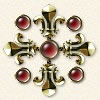 |
17th
c. Costume Glossary
|
 |
A | B | C | D | E | F | G | H | I | J | K | L | M | N | O | P | Q | R | S | T | U | V | W | X | Y | Z

Aguillettes: Metal-tagged laces that replaced the sewn ones,
to attach the breeches to the doublet.
Allonge-Perruqe: French term for periwig, also called state-wig. Worn by fashionable
men in the late 17th, early 18th century, introduced probably by
Louis XIV and usually in black or dark brown shades. The periwig
had very high "horns" on top of the forehead and was extremely long,
curled and flowing down the back and over the shoulders.
Amadis Sleeve:
Tight-fitting sleeve continuing on the back of the hand, invented
in 1684 by Mlle Le Rochois, an actress at the Opera, who had unsightly
arms.

Balagny cloak: first half of 17th century, cloak or cape
with wide collar, in France named after a military hero.
Baldrick: (French: Bandelier) Sword hanger, usually decorated with
exquisite embroidery, (often metal thread embroidery) and worn from
the right shoulder to the left hip, usually over the waistcoat or
earlier Bolero-style doublet, but under the coat or Justaucorps.
Frequently worn over the coat to show off the embroidery, when the
Baldrick had become very broad and long. The sword (rapier, later
also dress-sword) hangs very low at the knees.
Bandelier: see Baldrick.
Banyan:
Name given in England to men's jacket in Indian cloth. The term
is mostly used for indoor garments 'dressing gowns'.
Bas de Cotte
/ de Jupe / de Robe: In the second half of the 17th century
this term was used for the lower part of the petticoat or skirt,
which went with the petticoat or skirt body, covered by the gown
body.
Basques: Mid-17th century. French word for short tabs at bodices and male
doublets that extended below the waist. Those jackets with basques
were worn in combination with skirts instead of gowns.
Bonnet: ladies' headdress covering the back of the head and having the brim
in funnel form to shade the face.
Boot-hose: In the first half of the 17th century, stockings usually without
feet worn in the soft fashionable boots with turned cup-shaped tops
("bucket"-tops). The lace-edge of the boot-hose is turned over the
boot-tops. ("Cavalier"-style). They were worn over the silk stockings
to protect them in the long boots.
Bourdalou:
Hat-ribbon, finer than grosgrain, round the foot of the crown of
hats. This trimming is sometimes finished off with a buckle and
has been in use since the 17th century.
Brandenburg
coat: Fourth quarter of 17th century, a loose overcoat with
turned-back cuffs. The sleeves are made in one with the rest of
the garment.

Calache or Calash: A protective folding hood worn to protect
high headresses c. 1770s-1830s and made like a sunbonnet.
Canons,
also Cannons: 17th century, full, wide ruffles/flounces attached
at the bottom of breeches, especially Petticoat breeches. It was
a sort of half-stocking, at first long and narrow, then wider and
decorated with flounces and lace.
Capotain
or Copotain: A high conical, high crowned and small-brimmed
cap fashionable in the 16th century. In the mid-17th century worn
by supporters of the Puritan fraction in England.
Cassock,
also Casaque: Three-quarter length coat cut with wide, full
sleeves and wide throughout the body, ending at thigh-height or
below. An unbelted overcoat, open-sided and almost always covered
with braid and woven ornament. It was worn from the middle of the
16th century, mainly for hunting and riding.
Cavalier-style: The flamboyant men's fashion of the first half of the 17th century.
The supporters of the English king Charles I were called cavaliers,
in contrast to the plain dressed Puritans.
Cendal:
Silk material resembling taffeta. It was made in various qualities,
sometimes even mentioned as a luxury fabric, sometimes only as cheap
lining material. Widely used during the Middle Ages, but in the
17th century it was only used for lining.
Chaconne:
Type of cravat made of a ribbon dangling from the shirt collar to
the chest. It takes its name from the dancer Pécourt who
danced a chaconne in 1692 with his cravat tied in this way.
Chausses
en Bourses: Early 17th century breeches made in bands and padded
so they swelled out at the bottom, ending in a flattened balloon
shape.
Chemise:
A light undergarment made from linen, for both sexes.
Child's
Pudding: Small round hats for children made of cloth or straw,
forming a shock-absorber to protect them if they fell.
Chite:
Painted linen, originally from Chitta (India) which started the
fashion for painted linens in the 17th and 18th centuries.
Cockade: A ribbon bow deriving from the tie attaching the brim of a cocked
hat. Originally decorative, it was also used as political identification;
thus the white Cockade was worn by the Jacobites, and the Tricoleur
by the French republicans.
Cocked Hat: A hat which is styled with the brim turned up. Particularly applied
to styles of the 17th and 18th century.
Coif: Medieval to 17th century term for close-fitting head covering. Worn
in the later period exclusively by women.
Coiffure
en Bouffons: Women's hairstyle from the end of the reign of
Louis XIII: tufts of crimped hair over the temples, while the forehead
was covered by a fringe known as a garcette.
Commode: A wire frame on which the late 17th century high ladies' headdress,
the Fontange, was adjusted.
Conch or
Conque: Sort of large shell-shaped hat in gauze or light crepe,
mounted on a wire framework, which was in France mostly worn my
widows in the late 16th and early 17th centuries. At the same time
a similar veil, but generally much bigger and made of pale gauze,
seems to have been high fashion in England.
Cornet: Late-17th and 18h-century ladies' cap with pendant side pieces.
Cornet: The cornet headdress is a simplified Fontange. The cap has an upstanding
frill in front and lappets at the back. The veil is wired to stand
up above the forehead. A topknot of wired ribbon is pinned at the
front of the cap; fourth quarter of 17th century.
Couvrechef: A veil or covering for the head.
Cravat string: Ribbon used in the 17th century to tie a heavy lace cravat in place;
the forerunner of the 18th century Solitaire.
Cravat: Wide cloth or piece of lace knotted or tied around the neck. The
term was first used in the mid-17th century.
Culottes: French word for rather tight breeches.

Damask: Originally a silk fabric made in Damascus, only one
colour, with patterns of flowers, branches and animals in satin
finish contrasting with the slightly textured taffeta background.
Multi-coloured damasks are called lampas.
Devantière:
17th century women's riding costume split at the back.

Engagéantes: Lace cuffs with two or three rows of
ruffles, finishing women's gown sleeves in Louis XIV's time. They
were still worn in the 18th century with gowns à la francaise.

Facings: Edging of fine fur or rich cloth, these trimmings
were purely for decoration. During the course of time the meaning
changed towards the contemporary meaning of today: the term was
extended to cover all the revers of the body or sleeves of a garment.
Falling
bands: Also known as Rabat and Hanging collars; linen or lace
collars (or combined) with two distinct ends hanging down over the
chest. The forerunner of the cravat in the 17th century. They were
worn by both men and women.
Fichu: Large neckerchief at the end of the 18th century that was worn around
the neck and shoulders together with the Robe à L'Anglaise.
Flounce:
A band of cloth or lace fluting around a garment to which it is
attached only by its upper edge.
Fontange: A bow on a ladies' headdress worn in the late 17th and early 18th
centuries, named after The Duchesse de Fontanges. The term is often
incorrectly applied to the whole headdress.
Forehead
cloth or Cross cloth: 16th and 17th century term for a band
covering the front of a woman's head. It was often triangular.

Galants or Gallants: Small ribbon bows which were worn in
the mid 17th century in the hair and attached to the garments in
various places.
Garters:
Ribbon tied around the leg to hold up the stockings.
Gros point: Also known as Point de Venise and Venetian lace; very expensive
heavy lace from Venice, the most fashionable material for cravats
among aristocrats and royalty in the 17th century. The lace was
usually held together with a ribbon or cravat string, or sewn into
a pre-formed bow and fall because it was too heavy to be tied accurately.

Habit: In the 17th century it meant for men the suit of clothes
all in the same cloth or colour. The Court Habit in the 17th
and 18th centuries meant men's clothes, and the Grand Habit women's,
worn only at court and at festivities where the court was present.
Hurluberlu
or Hurlupe: Appeared about 1671, a female hairstyle in which
short curls covered the entire head.

Indiennes: In the 17th and 18th centuries the name given
to all Eastern painted and printed cloths, whatever their country
of origin.

Jabot: Originally the term meant the neck opening of the
chemise, and its lavce trimmings, showing through the opening at
the doublet. Early cravat of lace, often ready-made, worn during
the 17th century. The lace fell in a soft bunch to the upper chest
and was either knotted and draped or tied in a soft bow.
Jackboot: Over-knee high riding boot with square toes and low heel, made from
stiff leather. Second half of 17th century.
Jerkin:
Outer doublet worn in England in the late 16th and early 17th centuries.
It was sleeveless or with loose sleeves.
Justaucorps: Male coat developed in the second half of the 17th century. Tight
fitting in the shoulders, collarless and with flaring skirts and
knee-length. The flare was extended and made wider until the early
18th century. Later the coat became narrow, cut away in the front
and sides, with a standing collar. (Second half of 18th century).
Justeaucorps from French "juste-au-corps" = close fitting on the
body.
Jupe:
From the Arabic djuba, jacket. Jupe had two meanings
from the Middle Ages on towards the mid 17th century: jacket and
skirt. Only in 1672 did the Dictionnaire de l'Académie
Francaise define the term jupe: "Part of women's costume, from
the waist to the feet." The term had disappeared by then from men's
costume, except for the panels of certain garments. From the 1670s
on jupe/skirt corresponds with the modern meaning. In the
17th century women wore 3 jupes one on top of the other:
the modeste, a top skirt which often trailed; the friponne in the middle, which covered the secrète, the underskirt.
The latter two reached the ground.

Kontush, later Contouche: Generously cut caftan-shaped
mantle worn in Poland. The term passed to Germany and the Nordic
countries where it referred to women's gowns, robes volantes or gowns à la francaise worn in the 18th century.

Love lock: In the first half of the 17th century men grew
one lock longer than the rest of the long hair. It is tied with
a ribbon and laid to the front of the left shoulder ("Cavalier"-style).
Leading
strings or Tatas: Long narrow strips of cloth attached to the
shoulders of small children's dresses to hold them by when they
began to walk. These aids were used in the 17th and 18th centuries.
In England, in the 18th century, young girls wore these bands of
cloth until marriage.

Mantua, also Manteau: Widespread female dress of the late
17th century. Developed from a T-shaped garment, which is first
pleated informally at the shoulders and the waist pleats are controlled
by a belt. Instead of cutting the bodice and skirt as separate pieces
that were sewn together, bodice and skirt were cut in one length
from shoulder to hem. Cut to fall full in back and front, the garment
was worn over a corset and an underskirt. Front skirt edges were
often pulled to the back and fastened to form a draped effect, the
so-called waterfall-backdrape.
Marlborough
Bucket Boot: Thigh-high riding boot with cup-shaped wide top,
square toes and higher heels than the Jackboot. Made from stiff
leather; fourth quarter of 17th century to beginning of 18th century.
Mask:
Theatrical accessory in ancient times, it was adopted in the 16th
and 17th century by women, to protect the wearer's complexion and
preserve her incognito. See also vizor.
Modeste: French word for the outer layer of a skirt. The underlayer was called secrète.
Mouches: French word for small black patches worn on the face to hide little
blemishes. They came into fashion in the second half of the 17th
century and developed far into the 18th century a language of its
own, where they were exaggeratedly used even by men and available
in diverse shapes.
Muff:
Round band of fur or fur lined cloth to protect the hands from the
cold.

Neckcloth: Term used from the 17th century until ca. 1840
to describe either a cravat, stock, kerchief or bandanna worn around
the neck.
Negligée
cap: 18th century term for a cap worn within the house and also
informally.
Nightcap: Worn in bed or in the 16th to 18th centuries informally within the
house. Those worn by men were often exquisitely embroidered.

Palatine: Little fur stole which takes its name from the
Princess Palatine who, during the hard winter of 1676, wore a fur
as a cravat.
Paniers:
Underskirts stretched over metal hoops which appeared around 1718-20
in France and remained in fashion under various forms until the
French Revolution.
Dome shaped: en coupole. Round table: en guéridon.
Oval: paniers à coudes.
Pantofles: Female heelless slippers or mules worn during the 17th century,
but getting even more fashionable toward the end of the period.
They were made from brocade and embroidered leather.
Passacaille:
Fashionable dance (passacaglia), whose name was given to
the cord attaching the muff to the waist during Louis XIV's reign.
Passement:
Originally this was the name for all kinds of lace in the 16th and
17th centuries. No matter if it was made from linen threads, silk
or metal. Gradually, the name dentelle was given to lighter
work made with shuttles or needle, while passement developed
into Passementerie which describes all kinds of woven ornament.
Petite Oie:
set of ribbons which, in the mid 17th century, was used to trim
men's suits and which became very large when petticoat breeches were worn.
Petticoat
breeches, also Rhinegraves: Fashionable in mid 17th century
to around 1675, either a skirt-like construction or a divided skirt
with full, wide breeches and attached canons underneath. The legs
were loose and flowing.
Planchette: French word for boned and stiffened corset.
Plumpers: Small balls of wax that were placed in the cheeks by some women
to give the face a fashionable rounded shape from 1660-1700.
Pockets:
Even in the 17th century were the pockets still a small independant
bag attached to the gusset. It is only with the appearance of the justaucorps that pockets are to be found, usually vertical
at first, then mostly horizontal (from the 1680s onwards). Women's
pockets, in the 18th century, were attached on a string and worn
over the panier, to be reached by a slit on both sides of
the dress.
Point de
neige: Soft and fine lace with a small design ("snow flake"),
fashionable at the end of the 17th century.
Pomander: From the French word "pomme" for apple, still in use in the first
half of the 17th century by ladies. Small balls of perfume placed
in decorated, perforated boxes and worn around the waist on chains.
Pyjama:
The word derives from the Hindustani epai-jama. Pyjamas were
already worn in England in the 17th century and were called Moghul
breeches.

Rabat: In the 17th century the rabat was a collar of linen
and lace worn over the doublet. Ecclesiastics wore a narrower rabat
and this accessory for ecclesiastical town dress remained in use
for a long time afterwards.
Rhinegraves: see petticoat breeches. They are said to derive from Holland
or Germany.
Robe:
Originally this described all the furniture and effects belonging
to a person, then the meaning was gradually reduced until it denotes
a person's collection of clothing.
Robe à
L'Anglaise: Mid- to second half of 18th century dress that was
made with a fitted back called "en fourreau".
Robe de
Chambre / Robe Volante: In the 17th century the word had nothing
of the modern sense of déshabillé: it was simply
a gown differing from the court gown, and was admitted to
the chambres of the royal apartments outside receptions and ceremonies.
Ruff: Stiffened frill of lace or pleated linen, worn in the 16th and early
17th centuries. A forerunner of falling band and cravats.

Sack dress, also Robe à la Francaise: Mid- to second
half of 18th century dress that was made with a box pleated back
("Watteau"-pleats) falling loosely from just below the shoulder
to the floor.
Sack Gown
/ Robe Volante / Andrienne: A loose dress flaring out at the
bottom, the back attached to the neckband with gathers at first,
then with pleats. It was worn from about 1704 to about 1730-35.
Sash: In the 60s and 70s of the 17th century a broad, loosely knotted
sash was often worn around the hips over the coat by men. usually
made of silk and the edges decorated with tassled fringes.
Secrète: French word for under layer of a skirt. Two layers were always worn,
even when the outer layer modeste was closed in front.
Serpentaux:
Women's hairstyle, with almost straight hair hanging down, it followed
the coiffure en bouffons during the reign of Louis XIII.
Slashings:
Small openings made in a garment, showing the lining. Slashings
(crevés, chiquetades) were made in garments, shoes
and gloves.
Solitaire: Narrow black ribbon fashionable in the 18th century from about 1725
onwards. It was tied to the wig, then brought around to the front
of the neck and fastened, usually in a bow, over the stock.
Spur leather: A butterfly shaped piece of leather that was stitched across the
instep of soft, crumpling leather boots to hold the gold or silver
rowel spurs. First half of 17th century, "Cavalier"-style.
Steeple
crown hat: Having a high pointed crown and flat brim, and fashionable
in the first half of the 17th century.
Steinkirk,
also Steenkerk: Long cravat, often tipped with a fringe or lace,
worn with one end tucked through the buttonhole or pinned with a
brooch at the coat-front or waistcoat. Women tucked their cravat
into their corset laces. Fashionable among men and also for women
for several decades at the end of the 17th century and until the
mid-18th century. The name is said to come from the battle of Steinkirk
in Holland in 1692, when French soldiers were in too much of a hurry
to tie their cravats properly before going out to fight, but this
may be doubted, because apparently this fashion was already occasionally
seen earlier.
Stock: High-stiffened collar, covered with linen or black satin and fastened
at the back of the neck by strings or stock buckles. A piece of
material simulating a cravat was often sewn onto the front of the
stock. First introduced as military costume at the beginning of
the 18th century, and highly fashionable for the rest of that century.
Stomacher: In female garments a V-shaped section at the front of a boned, stiffened
under bodice. The stomacher filled in the upper part of the gown.

Tassettes: The basques of early 17th century doublets.
Tippet:
From the 16th century onwards it meant a short shoulder cape.
Tower: High female headdress fashionable in the late 17th and early 18th
century.
Tricorne: From French late 18th century term for hat with turned up brim and
having three corners.
Trousses:
In the 17th century the upper hose which did not hang down, but
fitted the thighs tightly. They are a survival of the 16th century grègues, preserved in the ceremonial costume of Knights
of the King's Order and in pages' costumes.

Vest or Veste: In the 17th and 18th centuries a man's
garment worn under the justaucorps, generally in rich material.
Originally almost as long as the coat, the vest was gradually shortened
and simplified until, in the middle of the reign of Louis XV, it
became the waistcoat.
Virago sleeves: Mid 17th century sleeves on female gowns and jackets that were paned
and tied into a series of puffs.
Vizard: A face mask worn by ladies in the 17th century to protect their
faces from the weather or even indoors. See also mask.

Waistcoat: From the Louis XVI period onwards waistcoats were
worn under all men's outer garments: coat, riding-coat, frock coat,
jacket, etc. usually the two front panels were made from fine material
and the back, which isn't seen, from lining material.
Watteau
pleat: Box pleat sweeping down from the shoulders to the hem
in the loose back of the gown.
Weepers:
White bands which were worn on the sleeve facings of coats and jerkins
in the 17th and 18th centuries as a sign of deep mourning.

Female
Costumes
Ladies'
Baroque Clothing
Indoor
Garments | Footwear | Accessories | Hairstyles | Head-dresses | Development
of the Fontange
Hairstyles
by Vermeer | Dress
Colours by Vermeer | Head-dresses
by Vermeer
Costume Focus Headwear & Neckwear | Costume
Focus Working Women
Costume
Focus Children's Clothing
Ladies'
Costume Quotes
Male
Costumes
Gentlemen's
Baroque Clothing
Indoor
Garments | Footwear | Accessories | Hairstyles | Head-dresses
Costume
Colours by Vermeer | Hair-
and Head-dresses by Vermeer
Gentlemen's
Costume Quotes
~ ~ ~ ~ ~ ~ ~ ~ ~ ~ ~ ~ ~
Embroidery Gallery | Gallery of Needlework
Engravings
Lace Gallery &
Identification | Glossary
Contents © N. Kipar 1997 |









